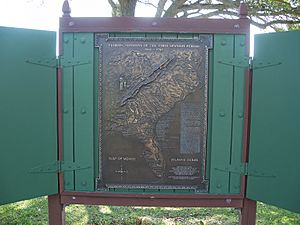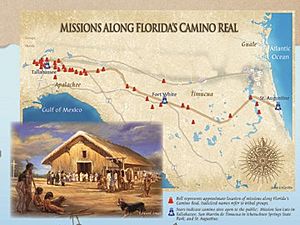Spanish missions in Florida facts for kids
In the late 1500s, the country of Spain started building special settlements called missions in a place they called La Florida. This area was much bigger than today's Florida. Spain wanted to teach Native Americans about Christianity. They also wanted to control the land better and stop other countries, like England and France, from settling there.
Spain never fully controlled all of La Florida. Their main power was in northern Florida, from St. Augustine to Tallahassee, and parts of southeastern Georgia. They also had some coastal towns like Pensacola, Florida. A few missions were built in other places for a short time, like in South Carolina and inland Georgia.
The missions in northern Florida and southeastern Georgia were grouped into four main areas. These were Apalachee, Timucua, Mocama, and Guale. These areas usually matched where different Native American groups lived and spoke their own languages. The mission areas could change over time as populations moved or changed.
Contents
History of the Florida Missions
Early Attempts and Challenges
Before the main missions, some priests traveled with Spanish explorers. But the first real mission trip was in 1549. Father Luis de Cancer and three other priests from the Dominican Order went to Tampa Bay. This trip failed quickly. After just six weeks, Father de Cancer was killed by the Tocobaga people. This event scared many missionaries in New Spain for a long time.
The first Spanish missions in Florida began when St. Augustine was founded in 1565. These early missions were often built near presidios, which were like forts. Between 1559 and 1567, Spain built ten forts along the coast. They hoped to stop other European countries from building bases on land Spain claimed.
Most of these forts did not last. For example, San Mateo was destroyed by the French. The soldiers at Tocobago were all killed. Many other forts were left empty because Native Americans were unfriendly, supplies were hard to get, or hurricanes caused damage. By 1573, only the forts at St. Augustine and Santa Elena (in South Carolina) remained. Santa Elena was abandoned in 1587. This left St. Augustine as the only large Spanish settlement in La Florida.
Jesuits and Franciscans Join the Effort
The missions near the forts were run by priests called Jesuits. But Native Americans were often hostile, and some missionaries were killed. Because of this, the Jesuits left La Florida in 1572.
Then, in 1573, Franciscan priests arrived. At first, they stayed close to St. Augustine. In 1587, the Franciscans began to spread their missions to the Guale and Timucua people along the Atlantic coast.
Starting in 1606, the Franciscans moved their mission efforts westward. They followed a long, simple road called El Camino Real. This road and the missions stretched across the Florida panhandle. They went through Timucua land and reached the Apalachee people near modern Tallahassee by 1633.
Decline of the Mission System
The mission system worked for many decades. The Spanish convinced most Native American village leaders to provide food and labor. In return, they offered tools and protection. But as the 1600s went on, the system grew weaker. Waves of European diseases often swept through, killing many Native Americans. There were also conflicts with English colonists from Carolina to the north.
The mission system finally collapsed after Queen Anne's War. Colonists from Carolina, along with their Creek allies, attacked Spanish Florida. They killed or captured most of the remaining Native Americans, except for those near St. Augustine and Pensacola.
The network of missions was almost completely destroyed by Carolina Governor James Moore. His attacks on northern Florida between 1702 and 1709 are known as the Apalachee massacre. Dozens of missions and villages were left empty by the early 1700s. Their locations were lost, as was much of the old El Camino Real road. Because of this, only a few mission sites in Florida have been found and clearly identified today.
Mission Architecture
The mission buildings in La Florida were built using posts stuck into the ground. Their walls were made from palmetto thatch, wattle and daub (a mix of woven sticks and mud), or wood planks. Some walls were left open. The floors were made of clay, and it is believed the roofs were thatched.
The church buildings in the missions were usually about 20 meters long and 11 meters wide. Other buildings were often inside a palisade, which was a fence made of strong posts. These included a convento (a house for the missionaries), a barracks (for soldiers), and often a separate kitchen.
Mission Provinces
The Spanish used the word "province" to describe the land of a Native American tribe or chiefdom. The borders of these provinces were not always fixed. If a tribe lost people or importance, their province might disappear from records. Other provinces would then grow to include those lands.
Most of the people who joined the mission system spoke the Timucua language. However, three other major language groups also became part of the missions:
- Guale Province: This was the land of the Guale people. It covered coastal Georgia and the Sea Islands north of the Altamaha River. The Guale were among the first people to join the mission system in the 1580s. Later, this province sometimes included the Mocama area to the south.
- Apalachee Province: This province included the Apalachee people, who spoke a Muskogean language. They joined the mission system in the 1630s. Their land was in the eastern part of today's Florida Panhandle, along the Gulf of Mexico coast.
- Mayaca-Jororo Province: The Spanish built an early mission among the Mayaca people, who did not speak Timucua. Later, they worked with the Mayaca and their relatives, the Jororo, in the late 1600s. This area was south of Lake George, on the upper St. Johns River.
Timucua-Speaking Provinces
Most Timucua-speaking groups joined the mission system in the late 1500s and early 1600s. The Spanish first saw them living in about a dozen different provinces. Some of the main ones were Acuera, Ibi, Mocama, Potano, Timucua (the main group), Utina, Yufera, and Yustaga.
Over time, as Timucuan populations went down, the Spanish combined many of these areas. They created a larger Timucua Province that stretched from the Atlantic Ocean to the Aucilla River.
- Mocama Province: This area included the coastal parts of southeastern Georgia and northern Florida. It went from St. Simons Island south to St. Augustine, and west to the St. Johns River. It had some of the earliest missions and served the Mocama people, who spoke a Timucuan language. Important missions here were San Juan del Puerto and San Pedro de Mocama.
- Timucua Province (Expanded): This province first served the people the Spanish called Timucua (now called the Northern Utina). They spoke the "Timucua proper" language. But it eventually grew to include several other Timucua-speaking areas, becoming the largest mission district in Florida.
After the Mocama missions succeeded, the Spanish built missions for the Agua Fresca (Eastern Utina) along the middle St. Johns River. Missions for the Potano people, near Gainesville, were part of the Potano Province. Missions for the Acuera, who lived near the Ocklawaha River, were part of the Acuera Province.
Most of these areas eventually became part of the larger Timucua Province. This happened partly because Native American populations had dropped so much that they could not support many separate missions. (Missions in Acuera Province were abandoned after the Timucua rebellion in 1656.) At this point, the Timucua Province covered the area between the St. Johns and Suwanee rivers. Later, the Yustaga Province, which served the Yustaga people, was added. This made the Timucua province cover most of north-central Florida.
The coastal area south of Mocama Province and St. Augustine was called La Costa. This area had some Timucua speakers but not much mission activity, perhaps because fewer people lived there. There were also a few missions built north and west of the Apalachee Province.
List of Spanish Missions
- Apalo
- Santa Ana de Potano
- San Antón de Carlos (Calusa)
- San Antonio de Anacape/Enacape (Agua Dulce/Utina)
- San Antonio de Bacuqua (Apalachee)
- Asunción de Puerto (Chatot)
- San Augustín de Ahoica
- San Augustín de Urihica
- San Blás de Avino (Acuera)
- San Buenaventura de Guadalquini (moved to St. Johns River as Santa Cruz y San Buenaventura de Guadalquini)
- San Buenaventura de Potano
- San Carlos de los Chacatos
- San Carlos de Yatcatani
- Santa Catalina de Afuerica (Northern Utina)
- Santa Catalina de Guale (St. Catherines Island, Sapelo Island and Amelia Island, in succession)
- Santa Clara de Tupiqui (Sapelo River)
- Cofa (mouth of Suwannee River)
- La Concepción de Ayubale (Ayubale)
- Santa Cruz de Ajohica
- Santa Cruz de Cachipile (Arapaha)
- Santa Cruz de Capoli
- Santa Cruz de Tarihica (Northern Utina)
- San Damián de Cupaica (... de Cupahica) (... de Escambi)
- San Diego de Helaca/Laca, later moved to San Diego de Salamototo (on St. Johns River)
- San Diego de Satuache (Guale)
- Santo Domingo de Asao (Guale)
- Santo Domingo de Talaje (Altamaha River)
- Santa Elena
- Santa Elena de Machaba (Yustaga)
- La Encarnación a la Santa Cruz de Sábacola (Chatot)
- Santa Fe de Toloca/Teleco/Toloco
- San Felipe de Athulutheca
- San Francisco de Chuaquin (Arapaha)
- San Francisco de Oconi
- San Francisco de Potano (Potano)
- San Ildefonso de Chamini/Chamile (Arapaha)
- Santa Isabel de Utinahica
- San Joseph de Escambe (San José de Escambe) (Apalachee)
- San Joseph de Ocuya (San José de Ocuya)
- San Joseph de Sapala (San José de Zapala) (Sapelo Island)
- San Juan de Aspalaga
- San Juan (de) Guacara (on the Suwannee River)
- San Juan del Puerto
- San Lorenzo de Ibihica
- San Lorenzo de Ivitachuco (Apalachee)
- Santa Lucia de Acuera
- San Luis de Apalachee (Tallahassee), a U.S. National Historic Landmark
- San Luis de Eloquale (Acuera)
- San Luis de Talimali (Apalachee)
- Santa María
- Santa María de Ayubale (Apalachee)
- Santa María de Loreto (Tequesta)
- Santa María de los Angeles de Arapaha
- Santa Maria de Sena, on Amelia Island
- San Martín de Asunción de Puerto (Chatot)
- San Martín de Timucua/Ayacutu/Ayaocuto
- San Martín de Tomole (Apalachee)
- San Matheo de Tolapatafi (Yustaga)
- San Miguel de Asile (Yustaga)
- San Miguel de Potano
- San Nicolás de Tolentino (Chatot)
- Nombre de Dios
- Nuestra Señora de Guadalupe de Tolomato
- San Pedro de Mocama (Cumberland Island)
- San Pedro do los Chines
- San Pedro y San Pablo de Patale (San Pedro de Patali)
- San Pedro y San Pablo de Potohiriba (San Pedro de Potohiriba) (Yustaga)
- La Purificación de Tama
- San Salvador de Mayaca
- Santiago de Oconi (near the Okefenokee Swamp)
- San Sebastian
See also
 In Spanish: Misiones españolas en Florida para niños
In Spanish: Misiones españolas en Florida para niños



